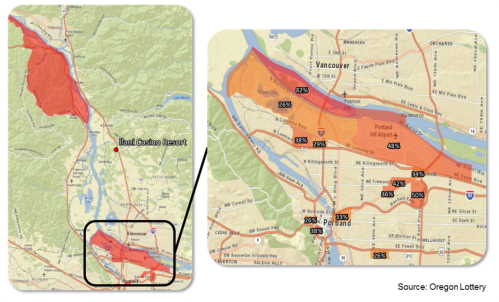By Josh Lehner
Oregon Office of Economic Analysis Blog
As the opening date for the Cowlitz Tribe’s Ilani Resort and Casino in La Center, Washington approaches, here is our office’s summary of the potential impact on Oregon Lottery revenues.
Our office continues to refine the estimated impact of the upcoming casino in La Center, Washington (16 miles north of Portland) which is set to open in “late spring” 2017. While the casino won approval a year or two ago, legal challenges remained and our office had previously taken a wait and see approach before adjusting the outlook accordingly. Beginning with the June 2016 quarterly forecast, our office started incorporating the casino’s impact.
As of the March 2017 forecast, our office’s estimate of the casino’s impact is a loss of around $110 million per year in video lottery sales, or a nearly $72 million per year reduction in transfers. This represents the same impact that was assumed in the December 2016 outlook.
Back in June 2016, our office’s initial estimate of the casino’s impact was set at a loss of around $100 million per year in video lottery sales. This estimate was based off the Legislative Revenue Office’s previous work on the impact of the proposed Wood Village casino in 2012, with some updates to incorporate the improved economy and the like. That approach started by examining the total gaming market in the Portland region and estimating what share of the market the new casino would take. It was a top-down approach to arrive at an estimate.
In the September 2016 forecast, our office increased the estimated impact to around $120 million per year. This larger estimate was based on a bottom-up approach that started by examining video lottery sales at the individual retailer and neighborhood/zip code level. More than half of Oregon’s statewide video lottery sales occur within the Portland MSA. 11 percent of statewide video lottery sales occur within just the northern portion of the Portland MSA – from the St. Johns neighborhood through the Parkrose neighborhood, including Hayden Island. Anecdotal evidence plus statistical analysis indicated that the border effect with the State of Washington, which does not have video lottery in its bars and restaurants, was large. This is particularly true directly across the two interstate bridges in Portland. However such trends are also seen in the population centers along Oregon’s borders with California and Idaho too. If these northern Portland zip codes see a 40-50 percent decline in video lottery sales, that means total statewide video lottery sales would decline 4.5 to 5.5 percent. Factoring in additional losses of around 10-15 percent throughout the rest of the Portland region brings the statewide total impact to nearly 12 percent, relative to the no casino baseline.
Both the top-down and bottom-up approaches yielded fairly close estimates in terms of the impact of the new casino.
A few months ago the Oregon Lottery research team analyzed video lottery jackpot winner records. As seen in the map below, the share of such winners in neighborhoods (Census tracts) along the Oregon-Washington border are quite large. There is substantial cross-border activity. However, the share of Washingtonian winners in neighborhoods not along the border is considerably smaller, as is to be expected. Given the results of this new research, our office lessened the casino impact last quarter and brought it to the middle of the range established via the top-down and bottom-up approaches.
As always, our office will continue to work on refining the estimates and updating the likely impact in the coming forecasts. Once the new casino has been opened for at least a few months, we should have a better idea on what the initial impact on sales actually is.
Disclaimer: Articles featured on Oregon Report are the creation, responsibility and opinion of the authoring individual or organization which is featured at the top of every article.




